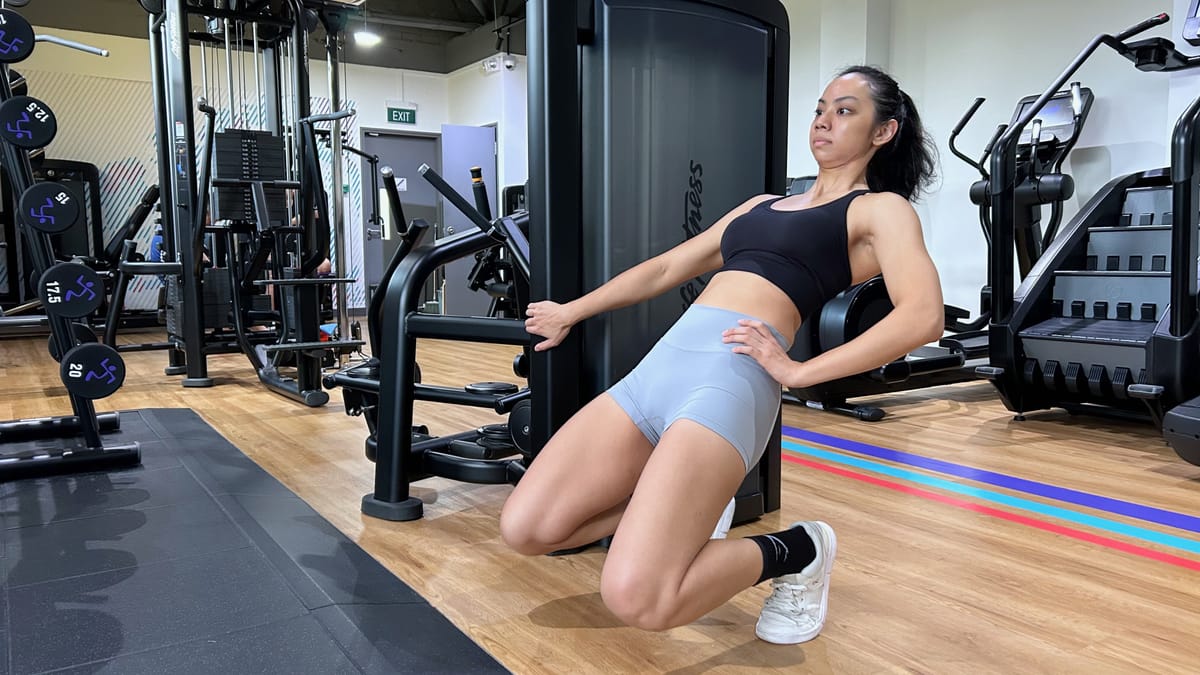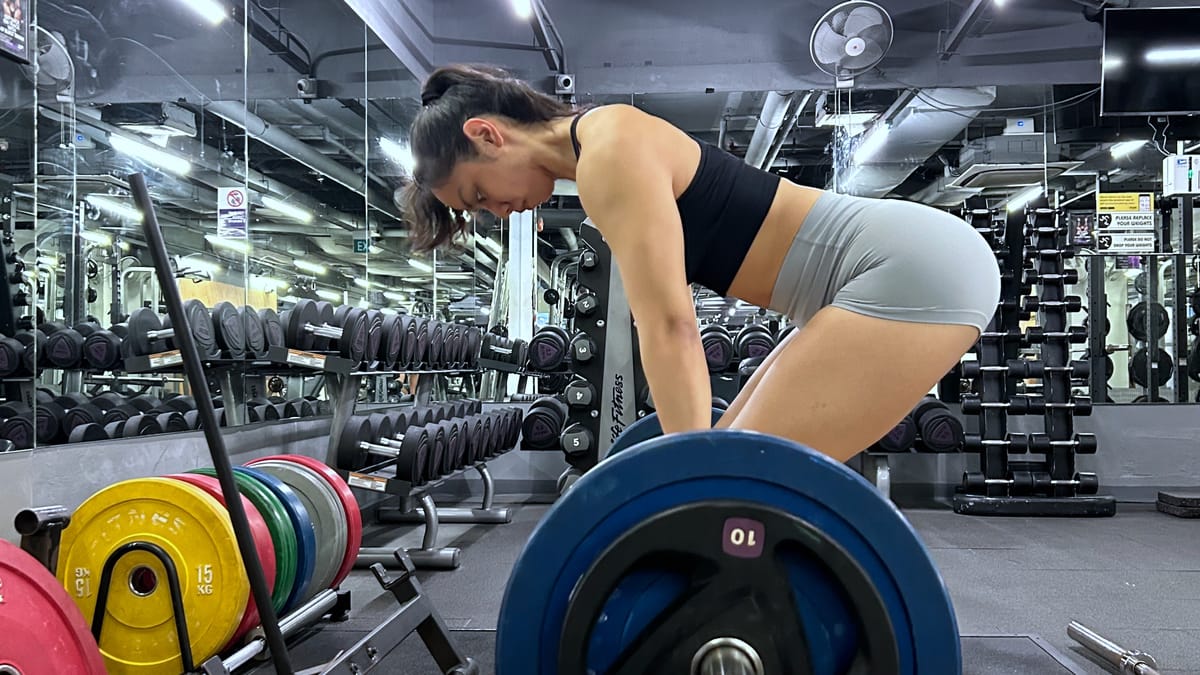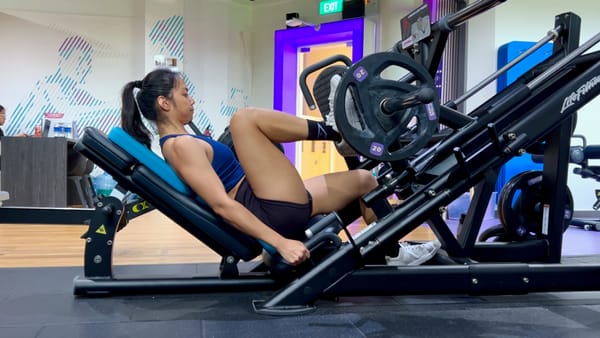14 Cable Leg Exercises: Most to Least Practical
Explore 14 cable leg exercises for your workouts. Ranked from most to least practical. Tips and limitations of every exercise included.

Cable machines might be used almost exclusively for upper body exercises. But don’t discount cable leg exercises just yet.
They can bring a whole other level of pain fun to legs day.
Of course, let’s be real — not every cable leg exercise is practical.
That’s why we’ve ranked them based on their practicality (high, average, low) and whether they’re worth adding to your workouts.
Why do cable leg exercises?
Before diving into the list, let’s take a quick look at the benefits of cable leg exercises.
Cable machines let you modify the resistance profile of exercises
Unlike free weights, cable machines are flexible in how they can be set up!
You can modify the resistance profile of almost any exercise by adjusting the height of your cable or your positioning from the machine.
This adds variety and flexibility to your training as you can train with resistance profiles that are impossible to get with free weights.
Cable machines are simple to set up and load
Being able to see the direction the cable is pulling in (line of force) makes setting up your exercises much easier.
It’s intuitive enough for most trainees to figure out with some experimenting.
Of course, we don’t have to mention the convenience of cable machines when setting up and changing weights. It’s instant, and you don’t have to worry about lugging weights across the gym.
Overview of cable leg exercises
Here are all the cable leg exercises we're going to talk about, categorized by how practical they are and their main limitations.
| Exercise | How practical? | Limitations |
|---|---|---|
| Cable goblet squat | Very | ROM, grip |
| Cable split squat | Very | ROM, balance |
| Cable Bulgarian split squat | Very | Balance |
| Cable step up | Very | Balance |
| Cable glute kickback | Very | Balance |
| Cable hip abduction | Very | Balance |
| Cable squat | Average | Max weight, grip, balance |
| Cable belt squat | Average | Max weight, setup |
| Cable RDL | Average | Grip, balance |
| Cable sissy squat | Not really | Balance, heel support |
| Cable calf raise | Not really | Max weight |
| Cable seated leg curl | Not really | Setup, only 1 leg |
| Cable lying leg curl | Not really | Setup, only 1 leg, support |
| Cable leg extension | Not really | Setup, only 1 leg, support |
#1: Cable goblet squat
Familiar with the goblet squat? Well, you can do it with the cable machine too.
Here’s a demo of the cable goblet squat (heel-elevated):
Best part of the cable goblet squat? Not having to worry about loading and holding onto a heavy dumbbell.
(🥲 Yes, we know the pain of holding the dumbbell up, especially when your legs demand weights that your upper body isn’t quite ready for.)
Tips for the cable goblet squat:
- Stand close to the cable: Keeps the line of force as vertical as possible to maximize efficiency
- Elevate your heels: Provides a greater ROM and keeps your torso more upright
- Set cable height as low as possible: Maximizes your depth
- Use a double D handle: Most comfortable attachment for the cable goblet squat
Limitations of the cable goblet squat:
- Reduced ROM: You might not be able to use your full ROM (depends on your setup and mobility)
- Hard to hold up: While easier to hold than dumbbells, holding the weight in a front rack position might still be difficult for some
Overall, the cable goblet squat is simple to set up and very convenient while not having any major drawbacks.
#2: Cable split squat
The cable split squat is another great exercise you can try.
Compared to double-leg options, single-leg exercises are a better fit for cable machines because they require less weight.
Here's a demo of the cable split squat:
Tips for the cable split squat:
- Elevate your front foot: Increases your ROM and knee flexion
- Set cable height as low as possible: Allows you to squat deep enough
- Don’t lean forward too much: Lean just enough to stay balanced
- Stand back far enough: Maintains tension on the cable from start to finish
Limitations of the cable split squat:
- Reduced ROM: Might not be able to enjoy your full ROM (depends on your setup and mobility)
- Balance with heavier weights: Might be hard to work with heavier weights as you need to constantly counterbalance the cable’s forward pull
On the whole, the cable split squat is a wonderful single-leg cable exercise with minimal drawbacks.
#3: Cable Bulgarian split squat
Like its free-weight version, the cable Bulgarian split squat is a wonderful exercise for your quads and glutes.
It’s just as painful, though, so moderate your expectations. (You can’t run from it.)
How to do the cable Bulgarian split squat:
Tips for the cable Bulgarian split squat:
- Keep your weight on the front foot: Keeps the load on the working leg
- Set cable height as low as possible: Allows you to squat deep enough
- Don’t lean forward too much: Lean just enough to stay balanced
- Stand back far enough: Maintains tension on the cable from start to finish
Limitations of the cable Bulgarian split squat:
- Balance with heavier weights: Could be difficult to use heavier weights as you need to constantly counterbalance the cable’s forward pull
Interestingly, you could also load the exercise from behind!
Facing away from the cable machine could make it easier to balance since the weight is more aligned with the direction that your body moves in when you squat.
Another way to load the cable Bulgarian split squat (from behind):
Overall, the cable Bulgarian split squat is an amazing option without any major downsides.
#4: Cable step-up
The cable step-up is one of our favorite cable leg exercises.
It’s easy to set up, and you don’t need much weight to get close to failure.
All you need is a sturdy plyo box.
A great example of the cable step-up:
@daniellewebsterfit#fit #gym #glutes #glutesworkout #fitnessmotivation #hypertrophy #glute ♬ Area Codes x Did It On Em by L BEATS - DJ L BEATS
Tips for the cable step-up:
- Keep your weight on the front foot: Keeps the load on the working leg
- Control your descent: Prevents your back leg from doing the work
- Hold for support: Grab the cable machine with your free hand for more stability
- Use enough elevation: Allows you to work with your full ROM
Limitations of the cable step-up:
- Balance with heavier weights: Might be tricky to do with heavier weights as the cable will be pulling you forward quite significantly
On the whole, the cable step-up has plenty to offer and pretty negligible downsides.
#5: Cable glute kickback
We don’t need to talk much about this one. If you love training glutes, the cable glute kickback is already your bread and butter.
The best part of the cable glute kickback? It targets your gluteus medius, which is often overlooked by other glute exercises.
Some background: most glute exercises you’re familiar with mainly target the gluteus maximus (the largest and strongest glute muscle). Examples include the hip thrust, split squat, and deadlift.
Wonderful demo of the cable glute kickback:
Tips for the cable glute kickback:
- Elevate your foot: Prevents your foot from scraping the floor and limiting ROM
- Kick back at an angle: Targets the gluteus medius more effectively (30 to 45 degrees)
- Control the movement: Avoid swinging with momentum or arching your lower back
- Hold for support: Grab the cable machine with at least 1 hand
Limitations of the cable glute kickback:
- Balance with heavier weights: Hard to work with heavier weights as the cable is pulling you forward, and you have minimal support
Want a more stable setup? Try the bench-supported cable glute kickback:
@coachbrooke_ym#gluteexercises #gluteworkouts #gymnewbie #gymtips #buildglutes #fittok #fitnessmotivation #fitnesstips ♬ Smoked out Phonk - TREVASPURA
Overall, the cable glute kickback is a tried-and-tested exercise that’s hard to find a good alternative to. Plus, you can use a bench to improve support. An all-round winner.
#6: Cable hip abduction
The cable hip abduction targets the glute muscles from an angle that’s often overlooked — straight out to the side.
This exercise works your hip abductors: primarily the gluteus medius, gluteus minimus, and tensor fasciae latae. (Yes, these are all glute muscles! Your butt isn’t 100% gluteus maximus.)
Want to cover all angles for glute training? Use the cable hip abduction and cable glute kickback to complement your glute workout.
How to do the cable hip abduction:
Tips for the cable hip abduction:
- Elevate your foot: Prevents your foot from scraping the floor and limiting ROM
- Control the movement: Avoid swinging with momentum or leaning toward the machine at the top position
Limitations of the cable hip abduction:
- Balance with heavier weights: Tricky to work with heavier weights as the cable is pulling you sideways, and you have minimal support
Want a more stable setup? Try the quadruped cable hip abduction:
All in all, the cable hip abduction is a great glute exercise with no major issues.
#7: Cable squat
We’re almost sure you’ve never tried this cable leg exercise before.
TBH, with so many options for squats, cable machines simply don’t end up high on the list.
That said, cable squats could be a great tool for training legs!
How to do the cable squat (aka Brignole squat):
Tips for the cable squat:
- Elevate your feet: Gives you greater ROM and knee flexion
- Set cable height as low as possible: Maximizes your depth
- Lean back slightly: Balances the forward pull of cable for more stability
- Push backward slightly: Aligns better with line of force (feels similar to a hack squat)
Limitations of the cable squat:
- Max weight might be insufficient: Could be maxed out by advanced trainees
- Balance with heavier weights: Difficult to use heavier weights as the cable is pulling you forward and off-balance
- Grip with heavier weights: Might not have enough grip strength with heavier weights
Overall, the cable squat is a good alternative to have in your arsenal. You might not be able to go very heavy, but it can still be a great complement to all the other leg exercises you do.
#8: Cable belt squat
Can’t find a belt squat machine? The cable belt squat is a viable alternative.
Of course, it’s a little more DIY.
Just like the step-up, the cable belt squat requires plyo boxes — 2 to be exact. Make sure they’re stable enough, though, since you’ll have both feet on the boxes.
Tips for the cable belt squat:
- Use enough elevation: Lets you use sufficient ROM
- Set cable height as low as possible: Maximizes your depth
- Hold for support: Grab the cable machine with your hands for support
Limitations of the cable belt squat:
- Max weight might be insufficient: Could be maxed out by advanced trainees
- Setup might not be practical: Difficult to set up in a crowded gym or for a quick workout
The cable belt squat is a great alternative if you want to load the squat around your hips but don’t have access to the belt squat machine.
For a cable leg exercise though, it could be too troublesome to set up. Plus, you risk getting in the way of other gym users, especially during peak hours.
#9: Cable RDL
The cable Romanian deadlift (RDL) was really popular for a while because it helped many people “feel their glutes better on the RDL”.
TBH though, that’s largely an issue with technique. No matter which RDL variation you’re doing, focus on driving your hips back as far as you can while keeping a slight knee bend. That’s how you can “feel your glutes better”.
That said, the cable RDL is still a wonderful cable leg exercise for targeting your hamstrings and glutes.
Some pointers for the cable RDL:
Tips for the cable RDL:
- Set cable height as low as possible: Maximizes your depth
- Stand back far enough: Maintains tension on the cable from start to finish
- Keep lats engaged: Prevents back from stretching forward and losing stability
- Use a straight bar cable attachment: Gives a more natural shoulder and arm position
Limitations of the cable RDL:
- Balance with heavier weights: Hard to work with heavier weights as the cable is pulling you forward and off-balance
- Grip with heavier weights: Might not have enough grip strength with heavier weights
The cable RDL is a decent variation of the barbell RDL. While it has clear limitations, the cable RDL could still be a helpful tool for beginner to intermediate trainees working with manageable weights. And it doesn’t hurt that it takes just seconds to set up.
Single-leg cable RDL
Want a unilateral option? Try the single-leg cable RDL.
Here’s a demo of the single-leg cable RDL:
@laurensimpsonofficial Top 6 cable glute building exercises! 🍑 whats your fav? #fyp #glutesworkout #gymtok #cableglutes #rdl #glutegains #gym #gymmotivation ♬ Super Freaky Girl - Nicki Minaj
While it might seem less stable, the single-leg cable RDL doesn’t need you to work with as much weight. This makes balancing less of an issue here.
So, if you need a quick unilateral RDL, this is a great option to try!
#10: Cable sissy squat
The sissy squat is a tough quad exercise. We repeat: it’s tough AF.
To do it right, you need to collect all the Infinity Stones strength, flexibility, mobility, and balance. Because the cable sissy squat puts your quads through an insane ROM that very few leg exercises can replicate.
Now that we’ve got you thinking: “Can I do the sissy squat?” — let’s see how it’s done.
A lovely demo of the cable sissy squat:
Tips for the cable sissy squat:
- Elevate your heels: Maximizes your ROM and knee flexion
- Set cable height as low as possible: Maximizes your depth
- Stand back far enough: Maintains tension on the cable from start to finish
- Use a straight bar cable attachment: Gives a more natural shoulder and arm position
Limitations of the cable sissy squat:
- Balance with heavier weights: Difficult to use heavier weights as the cable is pulling you forward
- Heel support needs to be high enough: Sufficient height is needed for a stable setup to use your full ROM
While it’s a great option for training quads, the cable sissy squat has some downsides that are hard to overcome once you start progressing.
Plus, there are more stable variations of the sissy squat that are easier to overload and make progress with.
For more practical variations of the sissy squat:

#11: Cable calf raise
Of all the cable leg exercises we’ve talked about, the cable calf raise is arguably the simplest.
Grab the cables, stand on something to elevate your feet, and start the exercise!
Here’s the cable calf raise in action:
Tips for the cable calf raise:
- Elevate your feet: Allows your heels to stretch downward for maximum ROM
- Set cable height as low as possible: Maximizes your depth
Limitations of the cable calf raise:
- Max weight might be insufficient: Could be maxed out by advanced trainees
The cable calf raise is a perfectly fine option for beginner to intermediate trainees. But given the simple nature of the movement, you have plenty of better options in the gym.
Single-leg cable calf raise
If you’d like to overcome the weight limitation, try switching to the single-leg cable calf raise.
How to do the single-leg cable calf raise:
You don’t have to worry about running out of weights, plus you could potentially grab the cable machine with a free hand for additional support.
#12: Cable seated leg curl
Yes, leg curls can be done on the cable machine too. You just don’t see it very often.
In general, leg curl exercises are extra special because they target your hamstrings through knee flexion.
Fun fact: most leg exercises target your hamstrings through hip extension. Examples include RDL and back extension.
2 ways to set up the cable seated leg curl:
Tips for the cable seated leg curl:
- Set cable at knee height: Aligns the line of force to the movement
- 1 leg at a time: Makes it easier to control and remain stable
- Use an incline bench if possible: Gives you more support and greater ROM
- Stay far enough from machine: Maintains tension on the cable from start to finish
Limitations of the cable seated leg curl:
- Tricky setup: Lots of space and a plyo box (with enough height) needed
- Limited to 1 leg at a time: Doubles the amount of training time needed
While there are very few ways to replicate this particular movement effectively, the cable seated leg curl simply isn’t worth the effort to set up.
Besides, the leg curl machine (seated or lying) is a staple in most gyms. So, it’s very unlikely you can’t get access to one.
Use it only if you can’t get your hands on the hamstring curl machines.
#13: Cable lying leg curl
Similar to the seated version, the cable lying leg curl targets your hamstrings through knee flexion.
Here’s the cable lying leg curl:
Tips for the cable lying leg curl:
- Set cable at knee height: Aligns the line of force to the movement
- 1 leg at a time: Makes it easier to control and remain stable
- Prop hips up: Improves ROM and stability
- Stay far enough from machine: Maintains tension on the cable from start to finish
Limitations of the cable lying leg curl:
- Tricky setup: Lots of space needed
- Limited to 1 leg at a time: Doubles the amount of training time needed
- No support available: Can’t stabilize the movement by grabbing onto support
Unfortunately, the cable lying leg curl seems to fare worse than the seated version. There’s no way to generate more stability by holding onto a support, plus you’re taking up even more space.
(And TBH, we’re just not big fans of lying face down in the middle of the gym and becoming a roadblock.)
Psst, this is the only hamstring-building guide you’ll ever need:

#14: Cable leg extension
Now that we’ve covered leg curls, let’s talk about leg extensions!
The cable leg extension is a wonderful leg exercise for targeting your quads, specifically the rectus femoris (1 of 4 quad muscles).
In general, the leg extension is better at targeting your quads than even squats!
How to set up the cable leg extension:
Tips for the cable leg extension:
- Set cable at ankle height: Aligns the line of force to the movement
- 1 leg at a time: Makes it easier to control and remain stable
- Hold onto the plyo box: Improves ROM and stability
- Stay far enough from machine: Maintains tension on the cable from start to finish
Limitations of the cable leg extension:
- Tricky setup: Lots of space and a plyo box (with enough height) needed
- Limited support: No way to anchor your back for more stability
- Limited to 1 leg at a time: Doubles the amount of training time needed
Just like with the cable leg curls, the cable leg extension might work in a pinch.
But if you have access to a leg extension machine, it’d be much easier and more effective to just use that.
This beats spending time trying to get the box height and cable angles just right and hoping you don’t get in anyone’s way.
Limitations of cable leg exercises
Most of the cable leg exercises we’ve touched on share some common limitations.
Let’s do a quick recap of the main ones.
Difficult to balance or stabilize
Unlike free weights, cable machines will pull you toward them.
For many exercises, this becomes an issue as you have to constantly counterbalance this pull.
The more weight you use on the cable machine, the stronger the pull and the more destabilized you become.
As a result, you might reach a point where you could handle more weight but simply cannot because you’re thrown off balance each time.
This sounds like a good time to move on from the cable machine for a particular exercise.
Maximum weight available is not enough
Cable leg exercises that involve both legs can naturally handle quite a bit of weight.
For advanced trainees, you might even find yourself maxing out the weights available.
A quick fix would be to explore single-leg versions of the same cable exercise.
TBH though, in most cases, it’s more practical to simply abandon the cable option for exercises you need to use a lot of weight on.
Setup is too troublesome
Some cable leg exercises involve plenty of additional equipment, space, or both.
While that’s perfectly fine, these exercises take away a major benefit of cable exercises: the convenience.
When the setup becomes too much of a hassle, it’s probably time to explore other variations.
After all, your priority should always be consistency. And for that to happen, you need to enjoy your exercises.
Which cable leg exercise is right for you?
To choose the right options for your workouts, you need to make an honest assessment of how cable leg exercises fit into your program.
Here are 3 things you need to know.
Know why you're adding cable leg exercises
Start by thinking about your training program and how you could improve it.
These cable leg exercises could serve as an addition, a replacement, or even an alternative.
It’s entirely up to you, but try to make sure these changes are meaningful and can help you stay consistent in your progress.
For example:
- The glute kickback machine always smells terrible: Replace with cable glute kickbacks, so you don’t have to retch every rep (and wonder if you’re getting anything nasty on you)
- You can’t find good support for dumbbell step-ups in your gym: Switch it out with cable step-ups since you can hold onto the cable machine
- Can’t do Bulgarian split squats in peace as the dumbbell area is always busy: Use the cable Bulgarian split squat as an alternative
- You want a different resistance profile for your glute kickback: Replace the machine option with cable glute kickback so you can adjust the line of force
And yes, you can also add cable options simply because they keep things fresh for you.
Have fun training, right?
Know the limitations of each cable leg exercise
We have discussed the main limitations of every cable leg exercise above.
But do these limitations apply to you? Well, it depends.
And there’s only 1 way to find out — try them for yourself!
For example:
- You might not be going heavy enough for balance to become an issue
- Your gym’s layout makes the cable setup very fuss-free
- You are nowhere near maxing out the weights
Knowing what you can and cannot realistically achieve with every option helps you make a more informed decision about which cable exercise to choose.
Know your alternatives for each exercise
You don’t have to replace all exercises in your training program with the cable option.
Instead, you could simply save it as an alternative for when the gym is crowded or when you just want to try something new. That said, you’d still want to make sure the cable option for an exercise is at least your top 3 pick before adding it to your program.
After all, if you have 3 or more variations that you’d choose over it, the cable variation simply isn’t good enough for you.






